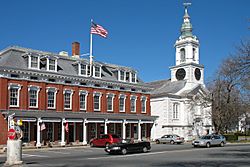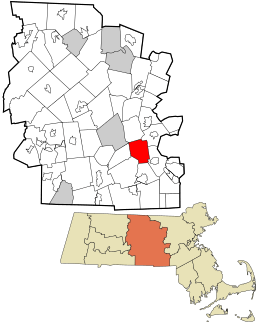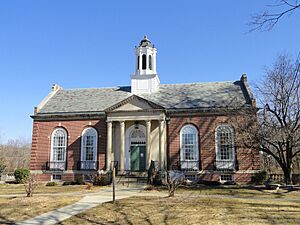Grafton, Massachusetts facts for kids
Quick facts for kids
Grafton, Massachusetts
|
|||
|---|---|---|---|

Grafton center in 2006
|
|||
|
|||

Location in Worcester County and the state of Massachusetts.
|
|||
| Country | United States | ||
| State | Massachusetts | ||
| County | Worcester | ||
| Settled | 1718 | ||
| Incorporated | 1735 | ||
| Government | |||
| • Type | Open town meeting | ||
| Area | |||
| • Total | 23.3 sq mi (60.3 km2) | ||
| • Land | 22.7 sq mi (58.9 km2) | ||
| • Water | 0.5 sq mi (1.4 km2) | ||
| Elevation | 425 ft (130 m) | ||
| Population
(2020)
|
|||
| • Total | 19,664 | ||
| • Density | 843.9/sq mi (326.10/km2) | ||
| Time zone | UTC−5 (Eastern) | ||
| • Summer (DST) | UTC−4 (Eastern) | ||
| ZIP Code |
01519, 01536, 01560
|
||
| Area code(s) | 508/774 | ||
| FIPS code | 25-26430 | ||
| GNIS feature ID | 0619480 | ||
| Website | www.grafton-ma.gov | ||
Grafton is a town located in Worcester County, Massachusetts, in the United States. In 2020, about 19,664 people lived here. The town is made up of three main areas: North Grafton, Grafton, and South Grafton. Each area has its own ZIP Code. Grafton became an official town in 1735. It is home to the Nipmuc village called Hassanamisco Reservation. You can also find the Willard House and Clock Museum, Community Harvest Project, and the Tufts University Cummings School of Veterinary Medicine here.
Contents
History of Grafton
Early Days and Native Americans
The Nipmuc tribe were the first people to live in this area. They still have a special reservation called Hassanamesit, or Hassanamisco. This place was once a "Praying Indian" village. It was started in 1647 when a missionary named John Eliot came and taught the Hassanamiscos about Christianity.
In 1727, the large Hassanamesit reservation was divided. Most of the land went to English settlers, and a smaller part went to seven Nipmuc families. This land eventually became the town of Grafton, which officially formed in 1735.
Grafton's Role in Industry
Grafton played an important part in the Industrial Revolution in the Blackstone Valley. The northern part of Grafton was once known as "New England Village."
The town helped with the American Industrial Revolution, which began in 1793. A man named Samuel Slater started the first cotton mill in Pawtucket, Rhode Island. Grafton's Upper Mill, now called the Washington Mills complex, used to be the New England Manufacturing Company. This mill, built in 1826, made abrasives. It was part of a much bigger factory area, but many parts were destroyed by fires over time.
Naming and Famous Connections
Grafton was named after Charles FitzRoy, 2nd Duke of Grafton. He was the son of King Charles II of England. In the early 1800s, Ethan Allen, a famous gun maker, had a factory in Grafton.
In the 1930s, a movie called Ah, Wilderness! was filmed in Grafton. The movie crew built a bandstand on the town common, and it's still there today! Grafton Common has many old homes, churches, and buildings. It's considered a very classic New England town common in the Blackstone Valley. The town is also part of the Blackstone River Valley National Heritage Corridor. This is the oldest industrial area in the U.S.
Heavy Industry and Healthcare
North Grafton is home to the Wyman Gordon Company. In 1955, the United States Air Force built a huge 50,000-ton metal forge here. It was part of their Heavy Press Program. This forge was the largest metal forge and machine in the world at the time! It's used to shape strong metals for airplanes. These metals are used for parts like turbine disks, shafts, and landing gear. They need to be light but super strong. Even the entire underside of the Space Shuttles was made in Grafton using magnesium.
From 1901 to 1973, North Grafton had the Grafton State Hospital. It started as a branch of the Worcester State Hospital. It was a "farm colony" where patients with long-term mental health conditions could live and work in a more normal setting. The hospital campus was very large, covering about 1,200 acres. After it closed in 1973, the land and many buildings were taken over by the Cummings School of Veterinary Medicine (part of Tufts University) and the Grafton Job Corps center.
Protecting Hassanamessit Woods
About 190 acres of the Hassanamessit Woods were almost developed for over 100 homes. This land is very important to the Nipmuc Tribal Nation. They believe it contains the remains of their old praying village and meetinghouse. However, several groups worked together to save it. These included The Trust for Public Land, the town of Grafton, the Grafton Land Trust, the Nipmuc Nation, and the state of Massachusetts.
The Trust for Public Land bought the property to protect it. They held onto it until enough money was raised in 2004 to keep it safe forever. This land is also important for nature. It is next to other protected lands, which helps protect local water quality. It also provides places for people to enjoy nature.
Geography
Grafton covers a total area of about 23.3 square miles (60.3 km²). Most of this is land, with about 0.5 square miles (1.4 km²) being water. Grafton is located about 40 miles (64 km) west of Boston. It is also about 5 miles (8 km) southeast of Worcester.
Besides North Grafton, Grafton, and South Grafton, the town also includes other small villages. These include Farnumsville, Fisherville, Saundersville, and Axtell Corner. These villages grew during the Industrial Revolution because of their location on the Blackstone River. Grafton shares borders with the towns of Shrewsbury, Westborough, Upton, Northbridge, Sutton, and Millbury. It also borders the city of Worcester.
Population Changes Over Time
| Historical population | ||
|---|---|---|
| Year | Pop. | ±% |
| 1850 | 3,904 | — |
| 1860 | 4,317 | +10.6% |
| 1870 | 4,594 | +6.4% |
| 1880 | 4,030 | −12.3% |
| 1890 | 5,002 | +24.1% |
| 1900 | 4,869 | −2.7% |
| 1910 | 5,705 | +17.2% |
| 1920 | 6,887 | +20.7% |
| 1930 | 7,030 | +2.1% |
| 1940 | 7,457 | +6.1% |
| 1950 | 8,281 | +11.1% |
| 1960 | 10,627 | +28.3% |
| 1970 | 11,659 | +9.7% |
| 1980 | 11,238 | −3.6% |
| 1990 | 13,035 | +16.0% |
| 2000 | 14,894 | +14.3% |
| 2010 | 17,765 | +19.3% |
| 2020 | 19,664 | +10.7% |
| 2023 | 19,975 | +1.6% |
Source: United States Census records and Population Estimates Program data. |
||
Grafton's population has grown steadily over the years. In 2010, the town had 17,765 people. By 2020, the population had increased to 19,664.
Getting Around Grafton
Public Transportation
The Grafton station in North Grafton has train service. It is part of the MBTA Commuter Rail Framingham/Worcester Line. The Worcester Regional Transit Authority also runs public bus service in Grafton. For older residents or those with disabilities, the Grafton Senior Center offers low-cost or free transportation.
Freight Rail
The Grafton and Upton Railroad provides freight train service. It runs between North Grafton and Milford.
Grafton Public Library
The Grafton Free Public Library first opened its doors in 1867. The building you see today was built in 1927. The money for its construction was given by Jerome Wheelock, who was an inventor from Grafton. In 2008, the town spent about $482,226 on its public library. This worked out to about $27 for each person in the town.
Schools in Grafton
Grafton has six public schools for students. Students are divided into different schools based on whether they live in North or South Grafton until they reach middle school. The school mascot for Grafton is the Gators!
- North Grafton Elementary School: for students in grades K–1
- South Grafton Elementary School: for students in grades K–1
- Millbury Street Elementary School: for students in grades 2–6
- North Street Elementary School: for students in grades 2–6
- Grafton Middle School: for students in grades 7–8
- Grafton High School: for students in grades 9–12
Local News
Newspapers
- The Community Advocate
Notable People from Grafton
Many interesting people have connections to Grafton:
- John Grover: He left Grafton in 1798, and a town in Ontario, Canada, was named Grafton after his hometown.
- Nicholas A. Basbanes: A journalist, author, and speaker.
- Dave Bayley: A music producer and the lead singer of the English band Glass Animals.
- Hugh Bradley: A first baseman for the Red Sox. In 1912, he hit the first home run at Fenway Park.
- Zara Cisco Brough: An engineer and a Native American activist from the Nipmuc Nation.
- Robert Catalanotti: A major general in the United States Army Reserve.
- Israel Chapin: A general during the Revolutionary War.
- Nicholas Gage: A journalist, writer, and film producer.
- George W. Hammond (1833–1908): A successful businessman.
- Pearl A. Harwood (1903–1998): A librarian and author of children's books.
- Titus Hutchinson: A judge and someone who fought against slavery.
- Joel Hills Johnson (1802–1883): An inventor, poet, and politician in Utah. He founded the Utah towns of Enoch and Johnson.
- Obi Melifonwu: An American football safety.
- Ifeatu Melifonwu: An American football defensive back for the Detroit Lions.
- Gordon M. Nelson (died 1993): He was the chairman of the Massachusetts Republican State Committee from 1976 to 1980.
- Frank O'Hara (1926–1966): An avant-garde poet and playwright.
- Marc Orrell: A former guitarist for the band Dropkick Murphys.
- Steve Spagnuolo: A former head coach for the St. Louis Rams. He is currently the defensive coordinator for the Kansas City Chiefs.
- Earl Tupper: He was from New Hampshire but started his famous Tupperware company in Farnumsville, South Grafton, in the 1940s.
- Jerome Wheelock: A notable inventor.
- John Adams Whipple: A pioneering photographer and inventor.
- Simon Willard and his brothers: Famous clock makers.
See also
 In Spanish: Grafton (Massachusetts) para niños
In Spanish: Grafton (Massachusetts) para niños




